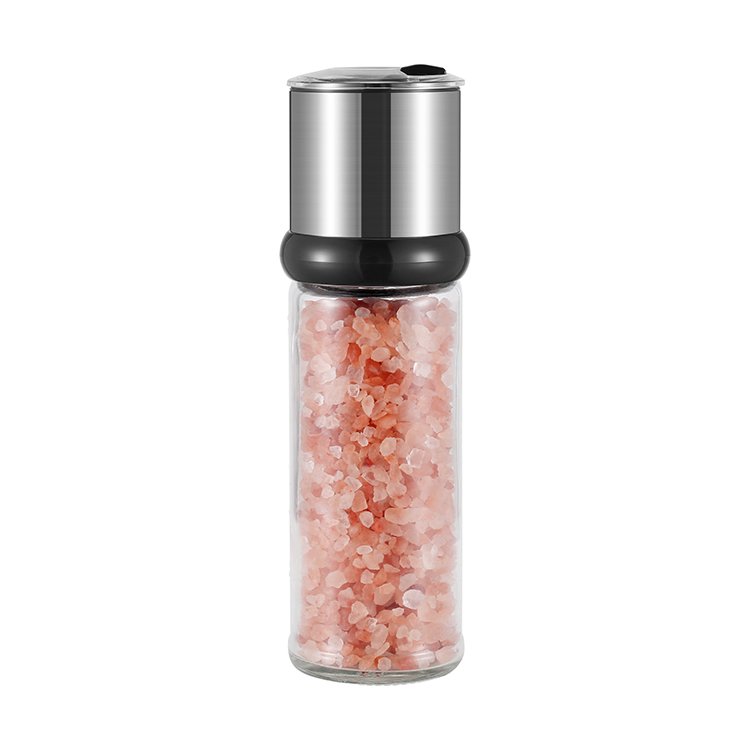
When choosing between rechargeable and non-rechargeable battery salt & pepper grinders, the decision can transform your cooking experience. Each type offers unique benefits that cater to different lifestyles and preferences. By understanding their differences, you empower yourself to select a grinder that enhances efficiency, convenience, and sustainability in your kitchen.
Key Differences in Battery Salt & Pepper Grinders

Power Source and Reusability
The power source is a defining factor when comparing rechargeable and non-rechargeable battery salt & pepper grinders. Rechargeable grinders rely on lithium-ion batteries, which deliver consistent power and longer runtimes. This means you can grind spices effortlessly without worrying about frequent recharges. Additionally, these grinders often include energy-saving features like automatic shut-off, ensuring the battery lasts longer and remains ready for use.
Non-rechargeable grinders, on the other hand, use traditional alkaline batteries. While these are widely available, they lack the reusability of rechargeable options. Once depleted, you must replace them, which can lead to higher long-term costs and increased environmental waste. If sustainability matters to you, rechargeable grinders are the clear winner.
Tip: Opt for rechargeable grinders if you want a more eco-friendly and cost-effective solution over time.
Performance and Consistency
Performance consistency is crucial for achieving the perfect grind every time. Rechargeable grinders excel in this area due to their steady power output. Lithium-ion batteries maintain consistent grinding speed and torque, ensuring uniform results whether you’re seasoning a salad or preparing a gourmet dish.
Studies also highlight the importance of material quality in grinder performance. For instance:
| Study | Findings |
| — | — |
| Li et al. (2023) | Optimized material properties enhance fatigue resistance. |
| Wang et al. (2021) | Fatigue failure mechanisms of grinding blades provide anti-fatigue insights. |
| Menapac et al. (2022) | Localized fatigue crack studies reveal the complexity of failure processes. |
Non-rechargeable grinders may struggle to maintain consistent performance as battery power diminishes. This can result in uneven grinding, which might affect the flavor and texture of your dishes. If precision matters to you, a rechargeable grinder is the better choice.
Portability and Convenience
Portability and convenience often influence your decision when choosing a grinder. Rechargeable models typically feature USB charging, allowing you to power them up anywhere with a compatible port. This makes them ideal for modern kitchens or outdoor dining setups. However, their built-in batteries add weight, making them slightly less portable than non-rechargeable options.
Non-rechargeable grinders are lighter and more compact, making them easier to carry during picnics or camping trips. However, they require you to pack spare batteries, which can be inconvenient. Here’s a quick comparison:
| Feature | Manual Grinder | Battery-Powered Grinder |
|---|---|---|
| Power Source | Hand-cranked | Battery or USB charging |
| Operation | Two-handed | One-handed |
| Portability | Lightweight | Heavier |
| Cost | Lower | Higher |
| Aesthetic | Traditional or rustic | Sleek and modern |
| Cleaning | Simple | Requires care with electronics |
If you prioritize convenience and modern aesthetics, rechargeable grinders are an excellent choice. For lightweight portability, non-rechargeable grinders might suit your needs better.
Pros and Cons of Rechargeable Battery Salt & Pepper Grinders
Advantages
Rechargeable battery salt & pepper grinders offer several benefits that elevate your cooking experience. Their lithium-ion batteries provide long-lasting power, allowing you to grind spices for months without frequent recharges. This reliability ensures uninterrupted performance, even during heavy use.
You’ll appreciate the convenience of adjustable grinding settings. With a simple dial, you can switch between coarse and fine textures effortlessly. This feature lets you customize your seasoning to suit any dish, whether it’s a hearty stew or a delicate salad.
Another standout advantage is their thoughtful design. Many rechargeable grinders include a bottom cap that prevents spice residue from spilling onto your countertops. This keeps your kitchen clean and reduces the hassle of post-cooking cleanup.
Tip: If you value efficiency, cleanliness, and versatility, rechargeable grinders are an excellent choice for your kitchen.
Disadvantages
Despite their benefits, rechargeable grinders come with a few drawbacks. Their built-in batteries add weight, making them heavier than non-rechargeable options. If portability is a priority, you might find this feature less appealing.
Rechargeable models also require access to a USB port or charging station. While this is convenient for modern kitchens, it can be limiting during outdoor activities like camping or picnics. You’ll need to plan ahead to ensure your grinder is fully charged before use.
Finally, the initial cost of rechargeable grinders tends to be higher. Although they save money over time by eliminating the need for disposable batteries, the upfront investment might feel steep if you’re on a tight budget.
Note: Consider your lifestyle and usage habits to determine if the advantages outweigh these minor inconveniences.
Pros and Cons of Non-Rechargeable Battery Salt & Pepper Grinders
Advantages
Non-rechargeable battery salt & pepper grinders offer several benefits that make them a practical choice for many users. Their lightweight design ensures easy handling, making them ideal for individuals who prioritize portability. Whether you’re hosting a picnic or enjoying a camping trip, these grinders fit seamlessly into your plans without adding unnecessary weight to your gear.
Another advantage is their affordability. Non-rechargeable grinders typically have a lower upfront cost compared to rechargeable models. This makes them an attractive option if you’re looking for a budget-friendly solution without compromising on functionality. Additionally, the widespread availability of alkaline batteries means you can quickly replace them whenever needed, ensuring your grinder remains operational at all times.
These grinders also shine in terms of simplicity. With no need for charging cables or USB ports, they offer a straightforward, hassle-free experience. You can use them immediately after inserting fresh batteries, making them a convenient choice for those who prefer minimal setup.
Tip: If you value portability, affordability, and simplicity, non-rechargeable grinders might be the perfect fit for your kitchen or outdoor adventures.
Disadvantages
Despite their benefits, non-rechargeable grinders come with certain limitations. The need for frequent battery replacements can lead to higher long-term costs, especially if you use your grinder regularly. Over time, this can become both inconvenient and expensive.
Another drawback is their environmental impact. Disposable batteries contribute to waste, which can harm the planet. If sustainability is important to you, this might be a significant concern. Furthermore, as battery power diminishes, the grinder’s performance may decline, resulting in uneven grinding and inconsistent results.
Lastly, non-rechargeable grinders lack the modern features found in rechargeable models, such as adjustable settings or energy-saving modes. This makes them less versatile for those who enjoy experimenting with different textures and flavors in their cooking.
Note: Consider how often you’ll use your grinder and whether the convenience outweighs the potential drawbacks before making your decision.
Cost Analysis of Battery Salt & Pepper Grinders
Initial Cost
When comparing the initial cost of battery salt & pepper grinders, you’ll notice significant variations based on brand, type, and features. Rechargeable models often come with a higher price tag due to their advanced technology and built-in lithium-ion batteries. For example, the Corkle USB rechargeable grinder is priced in the $$$$ range, reflecting its premium design and functionality. Similarly, the Urban Noon electric grinder falls in the $$$ range, offering a balance between affordability and performance.
Non-rechargeable grinders, on the other hand, are generally more budget-friendly. The AmuseWit electric grinder, priced in the $$ range, provides a cost-effective option for those seeking simplicity. For bulk buyers, products like the New Arrival Battery Salt Pepper Spice Mill are available at $4.70–$9.50 per unit with a minimum order of 2,000 pieces. If you’re looking for a mid-range option, the Cuisinart Gravity battery-operated grinder is available for just $35 on Amazon, making it an accessible choice for most households.
Long-Term Cost
While rechargeable grinders may have a higher upfront cost, they save you money in the long run. You won’t need to purchase disposable batteries repeatedly, which can add up over time. This makes rechargeable models a cost-efficient choice for frequent users.
Non-rechargeable grinders, however, require regular battery replacements. If you use your grinder daily, the cost of alkaline batteries can quickly surpass the initial savings. For occasional use, this might not be a concern, but for heavy usage, the expenses can become substantial.
Maintenance Expenses
Both types of grinders require minimal maintenance, but rechargeable models may incur additional costs if their built-in batteries degrade over time. Replacing a lithium-ion battery can be more expensive than buying new alkaline batteries for non-rechargeable grinders. However, with proper care and battery management, you can extend the lifespan of rechargeable grinders and minimize these expenses.
Non-rechargeable grinders, while simpler in design, may require more frequent cleaning due to the lack of advanced features like spill-proof caps. This could lead to slightly higher maintenance efforts, though the financial impact remains negligible.
Tip: Consider how often you’ll use your grinder and whether the long-term savings of a rechargeable model outweigh the convenience of a non-rechargeable one.
Choosing the Right Battery Salt & Pepper Grinder for Your Needs

Frequent Use
If you use your grinder daily, you need a model that can keep up with your lifestyle. Rechargeable battery salt & pepper grinders are ideal for frequent use. Their lithium-ion batteries provide consistent power, ensuring smooth and efficient grinding every time. You won’t have to worry about running out of batteries or dealing with uneven seasoning.
Non-rechargeable grinders, while convenient for occasional use, may not be the best choice for heavy-duty grinding. Frequent battery replacements can become a hassle and add to your expenses. If you cook often or enjoy experimenting with flavors, a rechargeable grinder offers the reliability and performance you need.
Tip: Choose a grinder with adjustable settings to customize your grind size for different dishes. This feature is especially useful for frequent cooks who want versatility in their seasoning.
Portability
Portability plays a crucial role if you enjoy outdoor dining or need a grinder that’s easy to carry. Non-rechargeable grinders are lightweight and compact, making them perfect for picnics, camping trips, or even small kitchens with limited space. You can toss one into your bag without worrying about added weight.
Rechargeable grinders, while slightly heavier, offer modern conveniences like USB charging. If you’re traveling to a location with access to power, this feature can be a game-changer. You won’t need to pack extra batteries, and you’ll enjoy the sleek, modern design that rechargeable models often feature.
| Feature | Rechargeable Grinders | Non-Rechargeable Grinders |
|---|---|---|
| Weight | Heavier | Lighter |
| Charging | USB or power outlet | Spare batteries required |
| Ideal For | Indoor use, modern kitchens | Outdoor activities, travel |
Note: If portability is your top priority, non-rechargeable grinders are the better choice. For a balance of portability and convenience, rechargeable models work well for short trips or home use.
Eco-Friendliness
Sustainability is becoming increasingly important in today’s world. If you want to reduce your environmental impact, rechargeable grinders are the way to go. Their reusable batteries eliminate the need for disposable alkaline batteries, which often end up in landfills. By choosing a rechargeable model, you contribute to a greener planet while enjoying long-term cost savings.
Non-rechargeable grinders, while convenient, rely on single-use batteries. These can create significant waste over time, especially if you use your grinder frequently. If eco-friendliness is a priority for you, consider investing in a rechargeable grinder.
Callout: Did you know? Switching to rechargeable battery salt & pepper grinders can significantly reduce your household waste and carbon footprint.
Ultimately, your choice depends on your values and lifestyle. Whether you prioritize frequent use, portability, or eco-friendliness, there’s a grinder out there that fits your needs perfectly.
Maintenance Tips for Battery Salt & Pepper Grinders
Cleaning and Care
Proper cleaning keeps your grinder in top condition and extends its lifespan. You should clean your grinder every 2–3 weeks to prevent residue buildup that can affect performance. Start by examining the grinding mechanism. Remove it carefully and check for wear or damage. Replace it if necessary to maintain consistent grinding results.
Use a damp, lint-free cloth to clean the housing. Avoid immersing the grinder in water, as this can damage the electronic components. Tighten any loose parts during reassembly to ensure smooth operation. For added efficiency, apply a food-safe lubricant to the moving parts. This reduces friction and restores the grinder’s smooth functionality.
| Maintenance Step | Description |
|---|---|
| Examine the Grinding Mechanism | Remove and inspect for wear or damage. Replace if needed. |
| Tighten Loose Parts | Secure all parts tightly during reassembly. |
| Lubricate Moving Parts | Use food-safe lubricant to reduce friction and improve performance. |
| Clean the Housing | Wipe with a damp cloth. Avoid water immersion to protect electronics. |
| Check Battery Compartment | Inspect for corrosion or leakage. Replace damaged batteries immediately. |
Battery Management
Efficient battery management ensures your grinder performs reliably. Always use high-quality rechargeable batteries for optimal results. Regularly check the battery compartment for signs of corrosion or leakage. Replace damaged batteries immediately to avoid unexpected failures.
If you own a rechargeable grinder, charge it fully before first use. Avoid overcharging, as this can reduce battery life. For non-rechargeable models, keep spare batteries on hand to ensure uninterrupted use.
Tip: Store batteries in a cool, dry place to prevent damage and extend their lifespan.
Storage Tips
Storing your grinder correctly protects it from damage and ensures it’s ready when you need it. Keep your grinder in a dry, dust-free area. Avoid placing it near heat sources or in direct sunlight, as this can warp the materials or damage the electronics.
For added protection, store your grinder upright with the bottom cap securely in place. This prevents spice residue from spilling and keeps your kitchen clean. If you’re not using the grinder for an extended period, remove the batteries to prevent leakage.
Callout: Proper storage not only prolongs your grinder’s life but also keeps your kitchen organized and clutter-free.
Choosing between rechargeable and non-rechargeable grinders depends on your priorities. Rechargeable models offer durability, eco-friendliness, and long-term savings, while non-rechargeable options provide affordability and portability.
| Feature | Battery-Operated Grinders | Rechargeable Grinders |
|---|---|---|
| Cost | Generally lower | Generally higher |
| Maintenance | Requires battery changes | Requires recharging |
| Durability | May wear out over time | More durable |
If you value sustainability and frequent use, go rechargeable. For occasional use or outdoor activities, non-rechargeable grinders are practical.
FAQ
What are the main benefits of rechargeable salt and pepper grinders?
Rechargeable grinders offer eco-friendliness, long-term cost savings, and consistent performance. They eliminate the need for disposable batteries, making them a sustainable and efficient choice for frequent use.
Are non-rechargeable grinders suitable for outdoor activities?
Yes, non-rechargeable grinders are lightweight and portable. They work well for picnics or camping trips, as you can easily carry spare batteries for uninterrupted use.
How do I maintain my battery-operated grinder?
Clean the grinder regularly with a damp cloth. Check for residue buildup and tighten loose parts. For rechargeable models, avoid overcharging to extend battery life.






